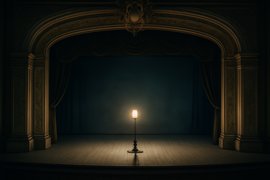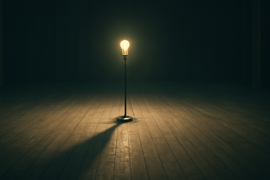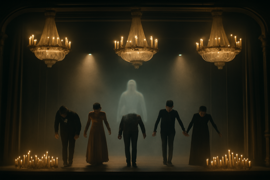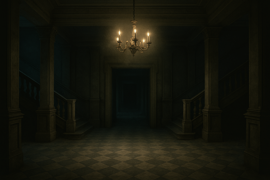Introduction
Under the antique marquee of the Proctor Theater, twilight settles like a velvet curtain. The oak doors remain locked, but behind their panels, shadowy shapes shift beneath dim sconces. Dust motes drift through narrow beams of dying daylight, coating ornate moldings that once gleamed with youthful grandeur. Patrons who once queued outside on hushed winter nights recall laughter and applause, but those recollections have grown distant with every passing decade. Now, only the bravest—or the most desperate—step through the threshold. Victoria Hale, the theater’s newly appointed general manager, carries a folder of yellowed news clippings detailing unexplained tragedies: a stagehand found frozen in place, an actress who vanished mid-performance, a musician whose final notes lingered in an empty pit. Her footsteps echo across the marbled foyer as she reaches for a tarnished brass key. A chill creeps along her spine, as if the walls themselves exhale a cold warning: you do not belong here. Yet with each measured click of her heels, she feels the theater’s pulse quicken, awakening a centuries-old presence. Outside, the streetlights flicker to life, casting the marquee’s neon letters into sharp relief against a starless sky. Victoria’s breath floats before her, a pale ghost in the gloom. She steels herself and pushes open the door. In that moment, the world beyond dissolves. Inside, only the theater remains—alive, restless, and hungry for stories.
The Gathering Shadow
From its grand opening in 1923 until the final curtain call of the Proctor Theater’s golden era, the hall brimmed with excitement. Broadway-caliber performers graced its stage, and every Friday the orchestra’s overture swept through the balcony, conjuring rapture among audiences in tailored suits and silken gowns. Yet beneath the velvet drapes and gilded balconies lay whispers of sorrow. By 1931, the Depression tightened its grip, forcing the theater into makeshift repertory programs that drew dwindling crowds. One evening, as a spirited adaptation of a popular revue played to half-empty seats, a fire broke out backstage. Flames licked the wooden beams, and amid the chaos, lead actress Eleanor Marlow leapt from a third-tier catwalk, clutching a torn script. Though she survived, Eleanor’s voice faltered thereafter, and her career collapsed like an extinguished candle. Within months, the theater closed for the first time in less than a decade.

Behind the proscenium arch, hidden corridors stretched like a spider’s web, used to shuttle guests and props unseen. In the months following Eleanor’s accident, maintenance crews reported cold spots that refused to warm even in high summer. Tools vanished; lanterns extinguished themselves. One electrician swore he heard footsteps behind him, though no one else occupied the corridor at the time. Management chalked it up to fluttering nerves in a downturned economy, but local newspapers gossiped about a “white silhouette” glimpsed in the reflection of stage flats. Theatre staff began to refer to the phenomenon as “the pale patron,” and superstitions grew.
With renovations in the 1950s, the Proctor Theater transformed into a cinema house. Flickering reels replaced live performances, but the rumors refused to subside. Projectionists claimed reels would snap unexpectedly at the moment of a tragic on-screen death, as though reality and film bled together. Guests reported muffled sobs in empty aisles—tears for tragedies nobody saw. One daring usher ventured backstage during a midnight showing and discovered a single child’s boot by the fly system, untouched by dust, as if dropped yesterday. When he picked it up, the air around him grew frigid, and faint strains of a sorrowful violin score played from the silent auditorium. He left the theater before dawn, convinced he had glimpsed Eleanor Marlow’s final bow.
In the 1980s, a local historian named Peter Vance compiled a dossier chronicling every report. Most intriguing was the account of a cleaning lady who found a diary concealed beneath the orchestra pit. The pages described clandestine rehearsal notes scribbled by a visiting troupe, including references to an abandoned ritual meant to guarantee a flawless run. According to the diary, the ritual backfired, claiming a life instead of invoking creative inspiration. The diary ended abruptly, the author’s handwriting trailing into an inkblot as if the pen had resisted its final confession. Attempts to locate that diary among the theater’s archives turned up nothing; some suggested the historian’s copy had vanished once he circulated it too widely.
Now, as Victoria Hale tours the dim backstage, she glances at oil paintings of past proprietors lining the foyer walls. Their eyes seem to follow her; one harbors a slight, knowing smile. She passes a velvet rope guarding access to the stage and senses a subtle tug, as though an unseen hand beckons her forward. When she reaches the rear catwalk, the proscenium’s ornate carving creates a perfect frame around the empty stage. In the ghostlight’s pale glow, she sees a flicker: a silhouette poised center stage, arms raised in silent applause. Before she can draw breath, the figure dissolves, leaving a single clap resonating through the rafters—proof that the Proctor Theater refuses to rest in peace.
Echoes on the Stage
Victoria’s reports of flickering lights and phantom applause drew the attention of Nolan Pierce, a seasoned paranormal investigator whose bold expeditions had been chronicled in regional magazines. When Nolan arrived, his equipment formed a line of blinking nodes across the orchestra pit, each sensor capturing minute fluctuations in electromagnetic fields. He mentioned that many ghost hunters focus on cold spots for evidence, but he looked for emotional imprints—residual traces of intense feelings. In the silent theater, he placed a small recorder beneath a seat marked by initials carved into the wood: E.M. 1928. He played back the tape an hour later under the proscenium. A faint voice whispered: “Encore,” followed by the soft patter of unseen footsteps dissolving into static.

In the weeks that followed, Nolan and Victoria organized after-hours vigils. They invited local performers to deliver monologues in the spotlight, as though paying tribute to past tragedies. More than once, cast members reported seeing darkened silhouettes mimicking their movements from the wings. An actress rehearsing a soliloquy froze in mid-sentence when she felt a cold hand clasp her shoulder. She spun around, only to face empty air. Yet the echo of her line lingered long after she fled the stage. Nolan recorded the room, capturing an EVP—Electronic Voice Phenomenon—that uttered a low moan of desperation. The word wasn’t intelligible, but the tone conveyed longing and regret.
Meanwhile, cracks appeared in the theater’s plasterwork near the balcony edge. Masonry crews tasked with repairs uncovered an alcove behind the wall, sealed for decades. Inside lay an assortment of personal effects: a faded rose pressed between playbills, a tarnished pocket watch stopped at midnight, a cracked photograph of a young couple—one in stage makeup, the other gasping as if struck. Victoria recognized the actress in the photograph: Eleanor Marlow. The man, she later learned, was her fiancé, a prop master who perished in the same backstage fire. Their clandestine romance had been kept secret to protect their reputations—until the fire consumed both careers.
On a cold November night, the team staged a final experiment: a staged performance of an unfinished play discovered in the hidden alcove. Actresses donned replica costumes, and Nolan stationed recorders along the fly system. As the lead recited the first lines, the proscenium curtains twitched on their own, revealing an empty stage behind them. The orchestra pit sprang to life with phantom strings, rasping in an otherworldly tempo. A violin note soared above their voices, as if Eleanor herself haunted the bowed instrument. Nolan’s breath hitched when the sensors registered a spike in EMF directly above the pit. Victoria shone her flashlight upward, revealing a flickering silhouette perched on a rafter. It bowed gracefully before dissolving in the haze.
That night changed everything. Nolan’s recordings amassed undeniable evidence: spectral melodies, disembodied words, and temperature readings that plunged twenty degrees below ambient. Victoria realized that the Proctor Theater’s haunting wasn’t malevolent. Instead, it was a memorial to lost artistry and severed dreams. The spirits remained tethered to the place they once called home, desperate to be seen and heard. As dawn broke, Nolan packed his equipment and agreed to present their findings to a national archive of paranormal research. He offered Victoria one final piece of advice: "Treat this theater not as a relic to be exorcised, but as a living monument. Let its ghosts claim their final applause."
The Final Performance
With spring unfurling green tendrils across the city, Victoria unveiled a masterstroke: a commemorative gala honoring the Proctor Theater’s centennial. Local actors, musicians, and historians collaborated to resurrect the concealed play found in the hidden alcove. Tickets sold out within hours, drawn by the promise of witnessing the “spirit of the stage” itself. On opening night, as the red velvet curtain rose, chandeliers overhead twinkled like constellations. Every seat was filled with curious eyes and buzzing anticipation. Behind the curtain, Victoria and Nolan exchanged a nod. They had prepared sanctified markers at intervals to measure fluctuations, but they anticipated goodwill more than havoc.

The play commenced under a gentle ghost light. The lead actress faltered when her microphone crackled with static, then cleared as if slipping away into silence. From the wings came a soft clarinet trill that hadn’t been cued. The audience murmured in excitement. As the ensemble reached its third act— the doomed lovers’ final meeting— the house lights faded to a cool twilight hue. From the balcony, an unseen orchestra began to play in perfect harmony. Nolan’s sensors registered the highest emotional imprint yet, and Victoria felt a warm breeze glide through the aisles. The crowd sat in awed hush, their breaths held collectively.
Moments later, at the climactic farewell, the silhouette of Eleanor Marlow appeared center stage. Wearing her period costume, she clasped her fiancé’s pocket watch before it slipped through her spectral fingers. The audience gasped as the figure moved with graceful clarity. Then, with a single sweeping bow, she dissolved into the beam of light, leaving behind a flourish of rose petals drifting through the proscenium. Nolan later confirmed on tape that a low, contented sigh followed the apparition. The theater trembled with applause so thunderous it shook the antique louvers in the walls. It was an ovation decades in the making.
After the performance, as guests mingled in the foyer, Victoria found Nolan smiling at the marble staircase. "They’ve found peace," he said softly. "Their story is finally told." Word of the manifestation spread online, thrusting the Proctor Theater into the spotlight as a must-visit destination for theater enthusiasts and paranormal aficionados alike. Renewed donations poured in for preservation, and the local historical society appointed Victoria as curator of the theater’s new archive. Rather than eradicate the haunting, they decided to celebrate it, weaving ghost tours into the theater’s calendar and inviting scholars to study its rich tapestry of memory and myth.
As midnight approached on the gala’s second evening, Victoria slipped backstage alone. She stood beneath the proscenium arch, now adorned with fresh roses. From within the wings came the faintest echo of a violin melody—an impromptu serenade from a grateful ghost. Victoria closed her eyes, letting the music rise and fall with the theater’s breath. Above, the balcony doors opened silently, and a gentle white glow formed in the darkness. Eleanor Marlow’s silhouette appeared one last time, eyes shining with gratitude. Then, she turned gracefully and ascended the rear staircase, ascending deeper into the theater’s history. Victoria watched until the glow faded into the night. When she finally left, the marquee gleamed above her in steadfast light, proclaiming: Live performances resume tomorrow.
Conclusion
The Proctor Theater endures as a living testament to the power of stories—both told and untold. Its velvet seats now cradle appreciative audiences once more, yet behind every standing ovation echoes a gratitude that transcends time. The spirits of past performers and patrons have woven themselves into the theater’s fabric, no longer restless but honored. When visitors traverse the polished marble foyer or ascend the painted staircases, they sense an undercurrent of presence, like a whispered benediction from the past. Paranormal investigators continue to log new findings, from gentle drafts that mimic choreography to fleeting glimpses of period costumes drifting across the stage. But the Proctor Theater no longer fears its reputation for hauntings; instead, it embraces them as integral to its charm and allure.
Victoria Hale stands at the foot of the stage each evening before a show, pausing to acknowledge the unseen audience members who walk with her. In doing so, she ensures that the legacy of Eleanor Marlow and her fellow artists lives on in every note sung, every line delivered, and every silent prayer uttered beneath the ghost light. The theater thrives on this delicate harmony between the living and the spectral, proving that sometimes the most compelling performances are those that bridge life and afterlife. When the final applause fades and the house lights dim, the Proctor Theater sleeps peacefully—its ghosts finally at rest, content in the knowledge that their stories continue to enchant, inspire, and terrify new generations. In the heart of this historic stage, the curtain never truly falls; it only transforms, ensuring that the tale of the Haunted Proctor Theater will be told for decades to come, long after the last echo has settled into echoes of memory and myth alike.
From whispered rumors in the lobby to the thunderous ovation of a resurrected play, the Proctor Theater’s journey from silent shadows to triumphant rebirth stands as a testament to the enduring bond between performance and spirit. Here, every footfall on the stage carries not only the promise of entertainment but also the reverence of a history that refuses to be forgotten. The theater remains a living archive, where the past dances with the present, and where the flicker of a ghost light illuminates the infinite possibilities of storytelling. So, step inside, dear guest, and listen closely: in these hallowed halls, you might just find that you’re never truly alone. The ghosts applaud with you, cheering each act, each moment, each heartbeat of this beloved American landmark—forever alive in memory and marvel alike.

















